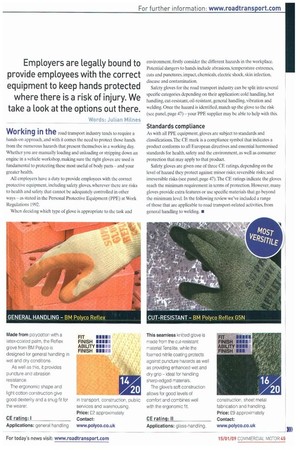Employers are legally bound to provide employees with the correct
Page 45

If you've noticed an error in this article please click here to report it so we can fix it.
equipment to keep hands protected where there is a risk of injury. We take a look at the options out there.
Words: Julian Manes Working in the road transport industry tends to require a hands-on approach, and with it comes the need to protect those hands from the numerous hazards that present themselves in a working day. Whether you are manually loading and unloading or stripping down an engine in a vehicle workshop, making sure the right gloves are used is fundamental to protecting these most useful of body parts — and your greater health.
All employers have a duty to provide employees with the correct protective equipment, including safety gloves, wherever there are risks to health and safety that cannot be adequately controlled in other ways — as stated in the Personal Protective Equipment (PPE) at Work Regulations 1992.
When deciding which type of glove is appropriate to the task and environment, firstly consider the different hazards in the workplace. Potential dangers to hands include abrasions, temperature extremes, cuts and punctures, impact, chemicals, electric shock, skin infection, disease and contamination.
Safety gloves for the road transport industry can be split into several specific categories depending on their application: cold handling, hot handling, cut-resistant, oil-resistant, general handling, vibration and welding. Once the hazard is identified, match up the glove to the risk (see panel, page 47) — your PPE supplier may be able to help with this.
Standards compliance
As with all PPE equipment. gloves are subject to standards and classifications. The CE mark is a compliance symbol that indicates a product conforms to all European directives and essential harmonised standards for health, safety and the environment, as well as consumer protection that may apply to that product.
Safety gloves are given one of three CE ratings, depending on the level of hazard they protect against: minor risks; reversible risks; and irreversible risks (see panel, page 47).The CE ratings indicate the gloves reach the minimum requirement in terms of protection. However, many gloves provide extra features or use specific materials that go beyond the minimum level. In the following review we've included a range of those that are applicable to road transport-related activities, from general handling to welding. •




















































































































































